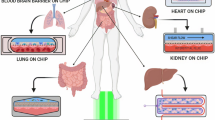Abstract
Cancer is one of the most common diseases afflicting humans. The use of biomarkers specific for tumor cells has facilitated their identification. However, technology has not kept pace with the field of molecular biomarkers, leaving their potential unrealized. Here, we demonstrate the efficacy of recognizing and capturing cancer cells using an antibody-based, on-chip, microfluidic device. A cancer cell capture biochip consisting of microchannels of size 2.0 cm long and 500 μm wide and deep, was etched onto Polydimethylsiloxane. Epithelial membrane antigen (EMA) and Epithelial growth factor receptor (EGFR) were coated on the inner surface of the microchannels. The overall chip measured 2.0 cm × 1.5 cm × 0.5 cm. Normal and tumor breast cells in a phosphate buffered saline (PBS) suspension were flowed through the biochip channels at a rate of 15 μL/min. Breast cancer cells were preferentially captured and identified while most of normal cells passed through. The capture rates for tumor and normal cells were found to be >30% and <5%, respectively. This preliminary cancer cell capture biochip design supports our initial effort of moving a BioMEMS device, from the bench top to the clinic.






Similar content being viewed by others
References
I. Caelen, A. Bernard, D. Juncker, B. Michel, H. Heinzelmann, and E. Delamarche, Langmuir 16, 9125 (2000).
R.Castellani, E.W. Visscher, and S. Wykes, Cancer 73, 344 (1994).
J.W. Chapman, E.B. Fish, and M.A. Link, Br. J. Cancer 79, 1508 (1999).
R.L. Chien and J.W. Parce, Fresenius J. Anal. Chem. 371,106 (2001).
M.A. Cuello, M. Nau, and S. Lipkowitz, Breast Dis. 15, 71 (2002).
A. Daridon, V. Fascio, J. Lichtenberg, R. Wutrich, H. Langen, E. Verpoorte, and N.F. De Rooij, Fresenius J. Anal. Chem. 371, 261 (2001).
M.B. Esch, L.E. Locascio, M.J. Tarlov, and R.A. Durst, Anal. Chem. 73, 152 (2001).
E. Evron, W.C. Dooley, C.B. Umbricht, and S. Sukumar, Lancet 357, 1335 (2001).
G.S. Fiorini and D.T. Chiu, BioTechniques 38, 429 (2005).
A. Folch, S. Mezzour, M. During, O. Hurtado, M. Toner, and R. Muller, Biochemical Microdevices 2 (2000).
S.A.W. Fuqua and Y. Cui, Breast Dis. 15, 3 (2002).
S.A.W. Fuqua, Mol. Cell. Biol. 22, 3373 (2002).
Q. Gao, V. Shi and S. Liu, Fresenius J. Anal. Chem. 371, 137 (2001).
M. Gion, L. Peloso, R. Mione, and G. Cappelli, Breast Dis. 21, 23 (2001).
S. Juodkazis, V. Mizeikis, K.K. Seet, M. Miwa, and H. Misawa, Nanotechnology 16, 846 (2005).
R.R. Kumar, A. Meenakshi, and N. Sivakumar, Hum. Antibodies 10, 143 (2001).
M.M. Ngundi, L.C. Shriver-Lake, M.H. Moore, M.E. Lassman, F.S. Ligler, and C.R. Taitt, Anal. Chem. 77, 148 (2005).
S. Nicholoson, J. Richard, and C. Sainsbury, Br. J. Cancer 63, 146 (1991).
D.J. O’Shannessy, M. Brigham-Burke, and K. Peck, Anal. Biochem. 205, 132 (1992).
Z. Quan and D.J. Bornhop, In: Lab Automation (Palm Springs, CA. USA, 2001).
J.G. Quinn, S. O’Neil, A. Doyle, C. McAtamney, D. Diamond, B.D. MacCraith, and R. O’Kennedy, Anal. Biochem. 281, 143 (2000).
J.S. Ross, G.P. Linette, J. Stec, E. Clark, M. Ayers, N. Leschly, W.F. Symmans, G.N. Hortobagyi, and L. Pusztai, Expert Rev. Mol. Diagn. 3, 573 (2003).
S. F. Sener, B. Cady, and D. Merkel, Cancer Pract. 10, 45 (2002).
L.C. Shriver-Lake, C.R. Taitt, and F.S. Ligler, J. AOAC Int. 87, 1498 (2004).
S.K. Sia and G.M. Whitesides, Electrophoresis 24, 3563 (2003).
M.S. Simon, D. Ibrahim, L. Newman, and M. Stano, Drugs Aging 19, 453 (2002).
A. Stromberg, A. Karlsson, F. Ryttsen, M. Davidson, D.T. Chiu, and O. Orwar, Anal. Chem. 73, 126 (2001).
C.R. Taitt, J.P. Golden, Y.S. Shubin, L.C. Shriver-Lake, K.E. Sapsford, A. Rasooly, and F.S. Ligler, Microb. Ecol. 47, 175 (2004).
F. Warnberg, H. Nordgren, L. Bergkvist, and L. Holmberg, Br. J. Cancer 85, 869 (2001).
H.J. Watts and C.R. Lowe, Anal. Chem. 66, 2465 (1994).
B. Zhao, N.O. L. Viernes, J.S. Moore, and D.J. Beebe, J. Am. Chem. Soc. 124, 5284 (2002).
Acknowledgments
This work was supported by DOD US Army Breast Cancer Research Program Idea Award DAMD-17-02-1-0581, and Robert A. Welch Research Foundation (D-1158) given to KHC.
Author information
Authors and Affiliations
Rights and permissions
About this article
Cite this article
Du, Z., Cheng, K.H., Vaughn, M.W. et al. Recognition and capture of breast cancer cells using an antibody-based platform in a microelectromechanical systems device. Biomed Microdevices 9, 35–42 (2007). https://doi.org/10.1007/s10544-006-9010-x
Published:
Issue Date:
DOI: https://doi.org/10.1007/s10544-006-9010-x




